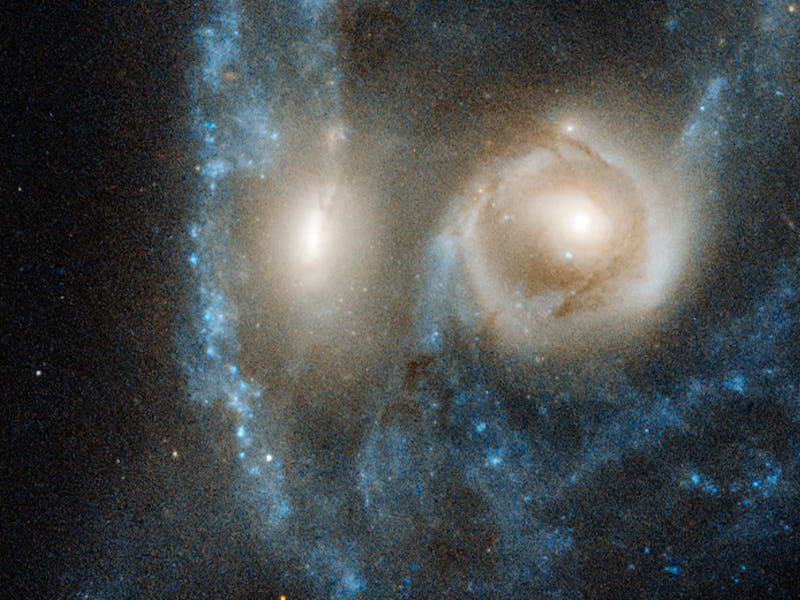If you look closely at this eerie image in the sky, you’ll see a galactic ghost
It’s the ghost of ‘Milky Way future’

It’s a galaxy-eat-galaxy world out there — often, quite literally. In the harsh environment of the cosmos, galaxies often collide, slowly devouring each other over a period that lasts between 1 to 2 billion years, before merging into one galaxy.
Hubble Space Telescope recently captured this grisly galactic process in action, revealing what appears to be a ghostly face in the night sky and, as one scientist warns, the future fate of our own galaxy.
The galactic system is referred to as AM 2026-424, and is located around 704 million light-years away from Earth (a light-year is the distance a beam of light travels in a single Earth year, approximately 6 trillion miles or 9.7 trillion kilometers).
The image was originally taken in July, 2019, and shows the adjacent cores of two galaxies as two bright spots, or the sort-of eyes peering out into space, while surrounded by a frenzy of newly forming stars. The disks of the galaxies, mainly made up of gas, dust and stars, were stretched outwards.
A head-on collision of two galaxies results in this ghostly face in the sky.
Ray Villard, a researcher at the Space Telescope Science Institute in Baltimore, and member of the team behind this latest image, says that they are on the hunt for peculiar looking galaxies to add to the catalogue of odd galactic bodies.
"I like finding weird stuff in space
“I like finding weird stuff in space,” Villard tells Inverse. “These guys smash together and make all kinds of weird shapes. And this one is particularly cute.”
Galaxies often exist in groups, and if one large galaxy happens to have an equally large or smaller sized galaxy as its cosmic nextdoor neighbor, then their gravitational pull will inch them closer and closer together before they eventually collide.
And much like collisions on the road between two cars, according to Villard, the damage caused by each ‘fender-bender’ varies depending on the angle at which the galaxies bump into each other.
“When the galaxies merge, the galaxy will stretch, and it will lose its spiral shape and just become very odd,” Villard says.
The two merging galaxies seen in the Hubble image have formed one giant, elliptical shaped galaxy, or the shape of a beach ball, as Villard puts it. The cores of the galaxies also merge, as well as their black holes which forms a more massive black hole, and all that action will trigger high rates of new star formation. “The stars get tossed around like a bunch of billiard balls on a table,” Villard adds.
In a way, the Hubble image is a cosmic premonition of the fate of our own galaxy, as the Milky Way is on a collision course with its neighboring Andromeda galaxy, which is estimated to take place in around 4.5 billion years.
Andromed is currently at a safe distance of 2.5 million light-years from the Milky Way, but it is approaching us at an estimated rate of around 250,000 miles per hour. That’s 2,000 times faster than a fastball, according to NASA estimates.
The Milky Way next to its galactic frenemy Andromeda
“Someone else looking at our galaxy in about 5 billion years will see some sort of weird collision,” Villard predicts.
If it is a head-on collision, our sun may be tossed into a different orbit, according to Villard. However, if we are really unlucky, then the sun may fall into the supermassive black hole at the center of our galaxy. “That’s pretty unlikely, it’s like shooting straight for the bull’s eye,” Villard says. “It’s not impossible.”
Although highly unfortunate, galaxy collisions happened even more frequently in the early universe as space was a little tighter than it is today, with the universe expanding over time, resulting in galaxies crowding each other more often. But, as Villard puts it, it doesn’t always have to be a melodramatic ending.
“That collision will trigger a new firestorm of star birth, planets and civilizations will be born after such a collision,” he says. “After destruction, there is rebirth.”